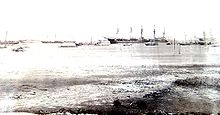Amba Mariam
Amba Mariam
ዐምባ ማሪያም | |
|---|---|
Debub Wollo | |
| Population (2005) | |
| • Total | 1,899 (est) |
Amba Mariam (
Based on figures from the
History

By the early 19th century, Magdala was a mountain stronghold, or
Emperor Tewodros II conquered Magdala on 22 September 1855.

The British entered the capital, where they rescued the diplomats. Before departing from Abyssinia, Sir Robert allowed his troops to loot and burn Magdala, including its churches. The expedition looted a large number of treasures and religious items such as
As of 2009[update] little remains of Tewodros's capital; the most visible item being Tewodros's
The abandoned fortress was occupied briefly by Lij
See also
Notes
- ^ Chisholm, Hugh, ed. (1911). . Encyclopædia Britannica. Vol. 17 (11th ed.). Cambridge University Press. p. 301.
- ^ CSA 2005 National Statistics, Table B.3 Archived November 23, 2006, at the Wayback Machine
- ^ Journals of the Rev. Messrs. Isenberg and Krapf, Missionaries of the Church Missionary Society, Detailing their proceedings in the kingdom of Shoa, and journeys in other parts of Abyssinia, in the years 1839, 1840, 1841 and 1842, (London, 1843), p. 357
- ^ Sven Rubenson, King of Kings: Tewodros of Ethiopia (Addis Ababa: Haile Selassie I University, 1966), p. 52
- ^ "The Magdala treasures in the British Museum". 22 February 2010.
- The Sunday Herald. Archived from the originalon August 10, 2011. Retrieved May 12, 2013.(hosted by Find Articles)
- ^ Odhiambo Okite, "Ethiopia: Returning a Tabot", Christianity Today, 22 April 2002. Retrieved 12 May 2013.
- ^ Damian Zane, "Raided Lost Ark returns home", BBC News, 1 July 2003. Retrieved 12 May 2013.
- ^ Harold Marcus, Haile Sellassie I: The Formative Years (Lawrenceville, New Jersey: Red Sea Press, 1996), pp. 24-30
